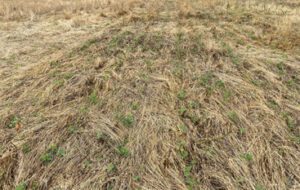
Article Written By: Zach Louk
Crop residue might be the single most frightening aspect of no-till to some farmers. Whether it is a simple soybean, corn, milo, or wheat stubble or a diverse cover crop mix, there seems to be hesitation when it comes to no-till seeding your next crop into heavy residue. The worry of how planting equipment is going to penetrate all that “trash” is a stumbling block on the route to soil health, but it is one that can easily be overcome and there is much to be gained. To the “untrained eye”, planting into a naked, tilled field may be one of the most aesthetically pleasing sights in farming – to see the bare soil with perfectly spaced row marks gives a sense of accomplishment and confidence. However, my eyes now see this for the shortcomings that accompany the tillage system and I remember that planting the seed is only the first act in the production of a profitable crop.
This year I took over a new farm, and as a younger farmer I am willing (maybe I don’t know any better) to take the problem fields. This parcel of land had laid idle all last year and on the edges and in random locations throughout the field were thick patches of annual winter grasses and everywhere else was either bare soil or had very little residue. I no-tilled soybeans into the field on June 6th and planting the crop went great. Seed depth and placement seemed to be adequate for the soil conditions, and less than 12 hours after planting I was “blessed” with over two inches of pounding rainfall in 45 minutes. Normally, we love to see rain right after planting, but this was not the kind we needed. One week of warm days and sunshine later I decided I had to go see what I had to deal with. Pulling up to the field, it looked as though somehow I had been lucky enough to capture a decent stand, but I quickly realized I had a problem and I learned a very important lesson about residue.
Anywhere in the field that I had planted through the patches of the winter annual grasses, including at the edge of the field drive, I had a good stand of freshly emerged soybeans. As SOON as the planter left the residue and was in the bare soil, there was less than a ten percent stand at best. As I examined the soil and the seedlings (or the lack thereof), I discovered what had happened. For a sensitive emerging crop, such as soybeans, soil crusting is one of the biggest problems with stand establishment in tilled, and even no-till, no-cover situations. As the rain came beating down, the residue from the annual grass absorbed the energy of the raindrop impact and protected the fragile soil underneath. This same protective barrier of residue blocked the sunlight from quickly drying out the soil and causing the crust. The bare soil had no protection and the beating of both the raindrop and then the sunshine caused a thick crust to form and prevented almost all of the soybeans from emerging.

Excellent stand of soybeans where there was enough “trash” to protect the soil surface from the impact of the raindrops.
Photo By: Zach Louk
In another of my fields, less than two miles away and planted on the same day, my soybeans planted into very heavy cereal rye had no problem emerging and having a successful stand. That cover crop saved me the cost of replanting the beans, gave me higher yield potential by preserving the optimal planting date and more importantly protected my valuable top soil that I have worked so hard to build.
Next time you wonder if all that “trash” is worth it or not, imagine how productive you could be if you only had to plant a crop once and imagine how much protection it is giving both your next crop and your soil!
This article first appeared in the 8th Edition of Green Cover's Soil Health Resource Guide.
Also check out the 10th edition, our latest Soil Health Resource Guide, over 90 pages packed with scientific articles and fascinating stories from soil health experts, researchers, farmers, innovators, and more! All as our complimentary gift to you, a fellow soil health enthusiast!